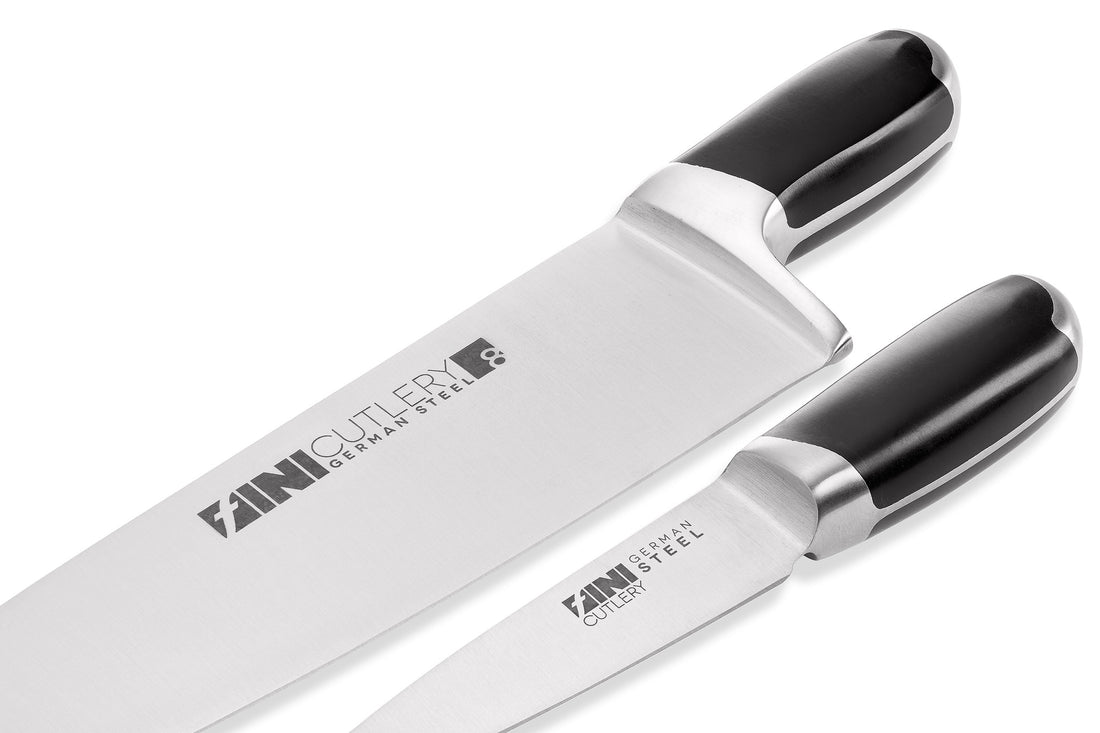Fini knives are all about finesse. By allowing your thumb and forefinger to naturally move into the pinch-grip position, your hand naturally grasps the handle, allowing for precise, controlled chopping, slicing and dicing.
The Grip
Grasp the top of the knife blade using your thumb and forefinger just in front of the bolster (the part of the blade that flares out where it meets the handle). Wrap the rest of your fingers around the handle. You'll feel the blade control transfer to your thumb and forefinger.
Rough Chopping
Rough chopping, also called rock chopping, takes advantage of blade's curve to perform a smooth rocking motion to chop leafy herbs, such as parsley and tarragon.
Herbs
- Place the stemmed herbs in a tight pile in the center of the cutting board. Grasp the knife using a pinch grip and set the blade to the left of the herbs on the cutting board.
- Next, place the fingers of your non-knife hand flat on the top of the knife blade, close to the tip. Chop through the herbs from left to right and back again.
- Turn the pile of herbs 90 degrees, pack them tightly and repeat. For a coarse chop, make three to four passes; for a fine chop, make seven or eight passes.
Garlic
Set a peeled garlic clove in the center of the cutting board. Crush the clove using the broad side of the chef's knife. Use the rough-chopping technique until the garlic reaches the desired fineness.
Dicing
When following a recipe, large dice typically means ¾-inch to 1-inch cubes, and medium dice means ½-inch cubes.
Potatoes
- Peel and rinse the potato. Peel off a little flesh from one side to make a flat base. Cut off the rounded tips from both ends of the potato and slice it in half lengthwise.
- Set a potato half on its side. Slice the potato half into even slices. Repeat with the other potato half.
- Stack three of four potato slices and slice them lengthwise into strips (also known as julienne when ¼-inch thick). Next, slice the strips crosswise into cubes. Store diced potatoes in cold water until you use them.
Tomatoes
- Core the tomatoes and slice them in half crosswise. Hold a tomato cut-side down over a bowl and gently squeeze it to loosen the seeds. Scoop out the seeds with the tip of a spoon.
- Set the tomato half on its side. Slice the tomato into even slices. Stack the tomatoes and slice them lengthwise into strips, then crosswise into cubes.
Slicing Onions
- Slice the tips (the root end and blossom end) off the onion. Slice the onion in half from end to end.
- Set the onion halves cut-side down on the cutting board. Slice the onion halves crosswise into slices.
Slicing Meat
Slice cooked meat across the grain using a sawing motion. To slice uncooked meat, use a back slice. Place the rear of the blade (close to the bolster) on top of the meat and draw the knife towards you.
Pro Tips
- Let the knife do the work. You don't need to use much force when using a well-maintained, sharp blade.
- Use a wooden cutting board. Besides handsome aesthetic appeal, wooden boards collect less bacteria than plastic boards.
- Curl the fingers of your non-knife hand away from the blade when cutting. Use the tips of your fingers, not the pads, to stabilize the ingredient on the cutting board.
- Use an offset serrated knife to slice tomatoes and lemons. Serrated blades provide traction on the skins and rinds while non-serrated knives don't.
- Stack basil leaves and slice them crosswise into thin strips for the chiffonade cut.
- Save clean vegetable trimmings for making stock and broth.

